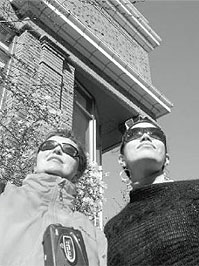If you’re searching for a bright green idea in the local arts scene, you’ll have to look up…. way up. In fact, you’ll have to look as high as the roof of the historic Royal Theatre, future home of the Solar Symphony Project. And while a Solar Symphony may sound like something you’d find performing on board the starship Enterprise, it’s actually a fascinating cost- and energy-saving concept whose time has more than come.
 |
| Solar power isn’t just for radios anymore: the Solar Symphony Project’s Natasha van Bentum (left) and Sheila Taylor. (Photo copyright Monday Magazine) |
Still very much in the research and development stage, the idea behind the Solar Symphony Project is actually surprisingly simple: to install a solar power array on the roof of the Royal. It would be tied into BC Hydro’s power grid, with a monitoring station in the lobby to help theatre users, and audience members, understand how solar power works. But rather than creating on-demand power to run the Royal’s lights and sound, the solar array would generate renewable power that would then be credited to the theatre’s BC Hydro account.
“We’re a very big power consumer,” says Lloyd Fitzsimonds, executive director for the Roay & McPherson Theatres Society, “but it’s demand power. It’s not like we’re regulated over 18 hours – a big fat lighting cue happens and we’re pulling power right now!”
As the man responsible for running the Royal, Fitzsimonds is intimately familiar with the cost of powering all those lights, so any possible saving is worth exploring – just don’t expect the Royal to be suddenly self-sufficient. “It’s not like we could build enough solar panels on the roof that we’d be off the grid,” he continues, “but we might get off it 10 percent, and even 10 percent is a pretty good piece of change.”
But for Fitzsimonds, the Solar Symphony Project is about more than mere economic savings. “More importantly, through, it’d say we’re simply being responsible citizens,” he insists. “We have an opportunity and we already have solar power technology, so if the sun is shining on the building today, that energy is just going to waste.”
Fitzsimonds credits the whole idea to Natasha van Bentum, the Victoria Symphony’s director of development.
“I’ve always had a keen interest with environmental issues,” says van Bentum, who has been working with local solar power gurus Carmanah Technologies to develop the project.
“I think a lot of performing arts organizations are missing the mark,” she continues. “There’s quite an opportunity here, because there’s a link between the types of people who attend and support, say, the Symphony, and the people who support environmental organizations.”
And van Bentum certainly knows of which she speaks – she previously spent a number of years working with Greenpeace International.
Carmanah, world leaders in solar technology, are more often found working in the military, industrial, marine and aviation industries, but it’s clear they’re quite keen on the whole Solar Symphony Project – and on tackling the Royal itself.
“Carmanah has provided many solar on-site electrical generation systems on new, state-of-the-art buildings in Canada, but this is the first time we’ve been asked to retroft a building that is almost 100 years old,” says Carmanah senior vice-president Dave Egles. “Carmanah is pleased to be a partner in this project, which we hope will set a precedent for the use of solar power in other theatre facilities throughout North America.”
Initial research money for the project is coming from last week’s PopStars! benefit concert at the Royal, but while she’s keen on their financial support, van Bentum is also quick to point out another aspect of their interest.
“The PopStars! support also sends a positive message to other, more pontentially major, funders that the community is on board with this,” she explains. “While this is some great grassroots support, the next step is to try and engage some major funders to come on board as well.”
The total cost for the project is in the $125,000 range, with a completion date all depending on money. “If we had an ange invest, a greeen philanthropy type, it could be done soon,” says van Bentum. “Very soon,. And from a business perspective, it will pay for itelf over a long-term period – and once it’s up and operating, at least we can say we’re a green symphony; then we can challenge other symphonies across North America to think along similar lines. Europe is way ahead of us in this area, but in North America, I don’t personally know of any other buildings that have this.”
And while symphony audiences are used to bing challenged artistically, both van Bentum and Fitzsimonds feel the Solar Symphony Project has benefits beyond the financial and technological.
“It send a very powerful message to new audiencces, especially young people, that we’re actually” – van Bentum pauses and laughs = “I don’t know if I’d say cool, but at least we’re with the program and think these things are really important.”
“Yeah, you’ve gott a love it when a little project like this actually pulls two arts companies together,” Fitzimonds laughs. “So ofte, it’s a disaster trying to work together, but this project is fun – it-s not really about the art, it’s actually about being responsible citizens.”
Now that’s a powerful project.